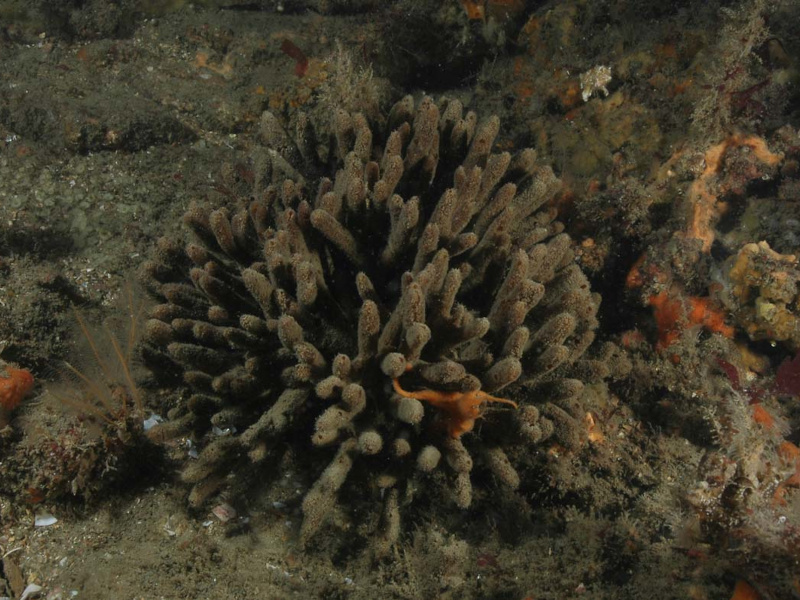Chocolate finger sponge (Raspailia (Raspailia) ramosa)
Distribution data supplied by the Ocean Biodiversity Information System (OBIS). To interrogate UK data visit the NBN Atlas.Map Help
| Researched by | Megan Maleed | Refereed by | This information is not refereed |
| Authority | (Montagu, 1814) | ||
| Other common names | - | Synonyms | Spongia ramosa (Montagu, 1814), Dictyocylindrus ramosus (Montagu, 1818), Raspailia (Raspailia) pumila (Bowerbank, 1866) |
Summary
Description
Chocolate to dark brown branching sponge, 15 cm in length, with up to 2.5 cm short thick branches, up to 1 cm in diameter arising irregularly from a short basal stalk. Branches are roughly circular in cross section. The exhalent openings (oscules) are typically visible underwater as small dark circles that evenly spread down the branches. A hairy or bristled (hispid) sponge, usually covered by dense layer of silt.
Recorded distribution in Britain and Ireland
Widespread along the west coast of Britain in the English Channel, the Channel Islands, and from Cornwall to northern Scotland and the Outer Hebrides. Recorded all around Ireland. Sparse records in the North Sea from Tyne and Wear and Norfolk.
Global distribution
Records of Raspailia ramosa in western and southern coasts of Britain and on all coastlines of Ireland. Sparse records from the North Atlantic Ocean and the North Sea.
Habitat
Common on sublittoral rock and boulders in semi exposed areas to sheltered regions with some tidal flow. The only Raspailia species known in harbours. Often encountered with other axinellid sponges. This species is epilithic, meaning it grows on the surface of rocks.
Depth range
0-120 mIdentifying features
- Bristly firm surface
- Distinguishable from other sponges for its dark brown colouration
Additional information
Although distinguishable in appearance from other sponges by its dark brown colouration, there are other rare Raspailia species from which the appearance is currently not known (Bowen et al., 2018).
Listed by
- none -
Bibliography
Ackers, R.G.A., Moss, D. & Picton, B.E. 1992. Sponges of the British Isles (Sponges: V): a colour guide and working document. Ross-on-Wye: Marine Conservation Society.
Bowen. S., Goodwin. C., Kipling. D. & Picton. B., 2018. Sea Squirts and Sponges of Britain and Ireland, Seasearch Guide. Plymouth: Wild Nature Press.
Hayward, P.J. & Ryland, J.S. (ed.) 2017. Handbook of the marine fauna of North-West Europe. Oxford: Oxford University Press.
Picton, B.E. & Morrow C.C., 2005. Encyclopedia of Marine Life of Britain and Ireland http://www.habitas.org.uk/marinelife/species.asp?item=D10920, 2008-01-08
Picton, B.E., Morrow, C.C. & van Soest, R.W.B., 2007. [In] Sponges of Britain and Ireland: http://www.habitas.org.uk/marinelife/sponge_guide/sponges.asp?item=C2134
Van Soest, R.W.M., Picton, B. & Morrow, C., 2024. Sponges of the North East Atlantic, 2.0. Leiden, Netherlands: Linnaeus NG - Naturalis Biodiversity Center. Accessed [2024-10-04]. Available from https://sponges-ne-atlantic.linnaeus.naturalis.nl/linnaeus_ng/app/views/introduction/topic.php?id=3392&epi=168
Datasets
Manx Biological Recording Partnership, 2022. Isle of Man historical wildlife records 1990 to 1994. Occurrence dataset:https://doi.org/10.15468/aru16v accessed via GBIF.org on 2024-09-27.
NBN (National Biodiversity Network) Atlas. Available from: https://www.nbnatlas.org.
OBIS (Ocean Biodiversity Information System), 2025. Global map of species distribution using gridded data. Available from: Ocean Biogeographic Information System. www.iobis.org. Accessed: 2025-08-08
Citation
This review can be cited as:
Last Updated: 30/09/2024



